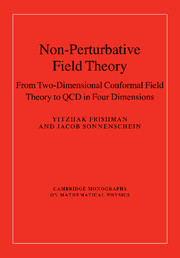Book contents
- Frontmatter
- Contents
- Preface
- Acknowledgements
- PART I NON-PERTURBATIVE METHODS IN TWO-DIMENSIONAL FIELD THEORY
- PART II TWO-DIMENSIONAL NON-PERTURBATIVE GAUGE DYNAMICS
- PART III FROM TWO TO FOUR DIMENSIONS
- 17 Conformal invariance in four-dimensional field theories and in QCD
- 18 Integrability in four-dimensional gauge dynamics
- 19 Large N methods in QCD4
- 20 From 2d bosonized baryons to 4d Skyrmions
- 21 From two-dimensional solitons to four-dimensional magnetic monopoles
- 22 Instantons of QCD
- 23 Summary, conclusions and outlook
- References
- Index
22 - Instantons of QCD
Published online by Cambridge University Press: 07 September 2010
- Frontmatter
- Contents
- Preface
- Acknowledgements
- PART I NON-PERTURBATIVE METHODS IN TWO-DIMENSIONAL FIELD THEORY
- PART II TWO-DIMENSIONAL NON-PERTURBATIVE GAUGE DYNAMICS
- PART III FROM TWO TO FOUR DIMENSIONS
- 17 Conformal invariance in four-dimensional field theories and in QCD
- 18 Integrability in four-dimensional gauge dynamics
- 19 Large N methods in QCD4
- 20 From 2d bosonized baryons to 4d Skyrmions
- 21 From two-dimensional solitons to four-dimensional magnetic monopoles
- 22 Instantons of QCD
- 23 Summary, conclusions and outlook
- References
- Index
Summary
In Chapter 5 we saw that solutions of the classical equations of motion, which are characterized by a topological number, play an important role in two-dimensional QFT. Derick's theorem (5.36) forbids scalar field soliton solutions in higher than two-dimensional space-time. However, for gauge fields one can bypass the theorem, and indeed, as we have seen in Chapter 21, there are solitons in the form of magnetic monopoles in four-dimensional gauge theories. The topic of this chapter will be solutions of the Yang–Mills theory defined on a Euclidean space-time which have finite action and are topological in their nature, the instantons. We will start with a description of the basic properties of one instanton solution including the topological charge that characterizes it. We then describe the construction of multi-instanton solutions and the moduli space of instantons including its dimension, complex nature, singularities and symmetries. When Wick rotated to Minkowski space-time the instanton describes a tunneling process between different vacua. We will elaborate on this phenomenon in the context of the four-dimensional YM theory. Various properties of QCD and hadron physics were thought to be related to instantons. In certain cases like confinement, the relation to instantons is still a mystery. One case where the role of instantons is clear is the U(1A) problem. This will be described in the last section of this chapter.
- Type
- Chapter
- Information
- Non-Perturbative Field TheoryFrom Two Dimensional Conformal Field Theory to QCD in Four Dimensions, pp. 389 - 406Publisher: Cambridge University PressPrint publication year: 2010



